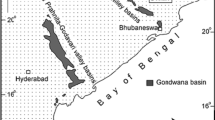Abstract
An embedded Markov model is used to test microlithotype analyses of subsections of a wide range of Australian coal seams for the presence of nonrandom sequences of lithologies. The data for individual seams, transformed to give five states (four states if dirt bands are excluded),were summed into geologically and geographically distinct groupings. The results suggest that dirt bands form an essential part of the sequences and that partial or complete cyclicity is present in many seam groupings. The cyclicity is either asymmetric or partially symmetric with the vitrite +clarite content of the coal decreasing upwards within each cycle. A new cycle is marked either by a sharp reversion, or by a slightly gradational reversion, to a vitrite +clariterich lithology. This reversion may or may not be preceded by a dirt band. In virtually all groupings, a vitrite +clarite-rich lithology is the most likely type after a dirt band. The sequences are similar to those that have been described in European coals and it seems probable that the presence of intraseam, cyclic sequences is a normal, rather than an unusual condition, within coal seams. This cyclicity is a response to changes in the sedimentation balance. These changes are probably due in large part to processes originating within the peat-forming environment but processes external to this environment are also likely to produce cyclic sequences of coal lithologies.
Similar content being viewed by others
References
Anderson, T. W., and Goodman, L. A., 1957, Statistical inference about Markov chains: Annals Math. Stat., v. 28, p. 99–110.
Cook, A. C., and Johnson, R. D., 1975, Seam thickness, quality and structure variation in the Bulli Coal, Sydney Basin, N.S.W.: Ann. Conf., Australas. Inst. Min. Metall., p. 537-550.
Duff, P. McL. D., and Walton, E. K., 1962, Statistical basis for cyclothems. A quantitative study of the sedimentary succession in the East Pennine Coalfield: Sedimentology, v. 1, no. 4, p. 235–255.
Gingerich, P. D., 1969, Markov analysis of cyclic alluvial sediments: Jour. Sed. Pet., v. 39, no. 1, p. 330–332.
Harbaugh, J. W., and Bonham-Carter, G., 1970, Computer simulation in geology: John Wiley & Sons, Inc., New York, 575 p.
Howell, D. J., 1974, Permian deltaic sedimentation, Western Coalfield, Sydney Basin: Abst. 9th Symp. on Advances in the Study of the Sydney Basin, p. 14–15.
ICCP, 1963, International Handbook of Coal Petrography (2nd ed.): Centre National de la Recherche Scientifique, Paris, France.
Johnson, K. R., and Cook, A. C., 1973, Cyclic characteristics of sediments in the Moon Island Beach Subgroup, Newcastle Coal Measures, New South Wales: Jour. Math. Geology, v. 5, no. 1, p. 91–110.
Kemeny, J. C., and Snell, J. L., 1960, Finite Markov chains: Van Nostrand, Princeton, New Jersey, 210 p.
Krumbein, W. C., 1967, FORTRAN IV computer programs for Markov chain experiments in geology: Kansas Geol. Survey Computer Contr. 13, 38 p.
Krumbein, W. C., 1968, FORTRAN IV computer program for simulation of transgression and regression with continuous-time Markov models: Kansas Geol. Survey Computer Contr. 26, 38 p.
Krumbein, W. C., and Dacey, M. F., 1969, Markov chains and embedded Markov chains in geology: Jour. Math. Geology, v. 1, no. 1, p. 79–96.
McCammon, R. B., and Wenninger, G. 1970, The dendrograph: Kansas Geol. Survey Computer Contr. 48, 28 p.
Read, W. A., and Dean, J. M., 1967, 1968, A quantitative study of a sequence of coalbearing cycles in the Namurian of Central Scotland: Part 1, Sedimentology, v. 9, no. 2, p. 137–156; Part 2, Sedimentology, v. 10, no. 2, p. 121–136.
Smith, A. H. V., 1962, The palaeoecology of Carboniferous peats based on the miospores and petrography of bituminous coals: Proc. Yorks. Geol. Soc., v. 33, p. 423–474.
Smith, A. H. V., 1968, Seam profiles and seam characters,in Coal and coal-bearing strata: Oliver & Boyd, Edinburgh, 418 p.
Smyth, M., 1970, Type seam sequences for some Permian Australian coals; Proc. Australas. Inst. Min. Metall., no. 233, p. 7–16.
Smyth, M., 1972, A petrographic study of the stratigraphy of Australian coal seams: unpubl. masters thesis, Univ. New South Wales, 142 p.
Stach, E., 1956, La sclerotinite et son importance pour l'origine de la durite: Proc. Int. Comm. Coal Pet., no. 2, p. 56–58.
Wanless, H. R., and Weller, J. H., 1932, Correlation and extent of Pennsylvanian cyclothems: Geol. Soc. America, Bull., v. 43, no. 4, p. 1003–1016.
Author information
Authors and Affiliations
Rights and permissions
About this article
Cite this article
Smyth, M., Cook, A.C. Sequence in Australian coal seams. Mathematical Geology 8, 529–547 (1976). https://doi.org/10.1007/BF01042992
Received:
Revised:
Issue Date:
DOI: https://doi.org/10.1007/BF01042992




